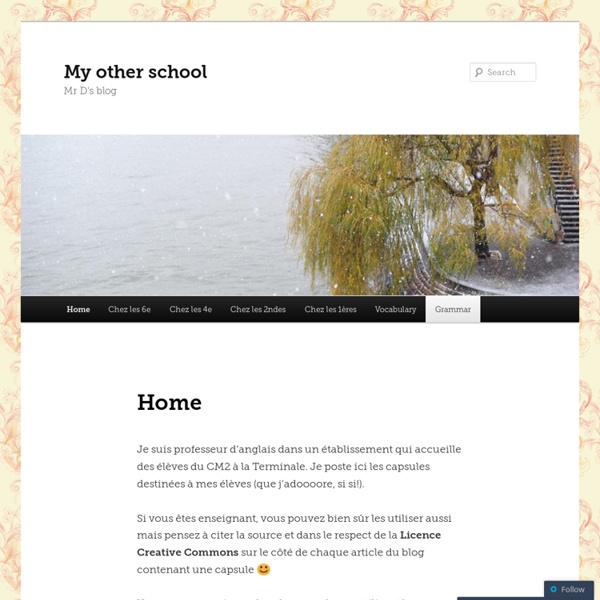



how to make storyboards What is a storyboard? Once a concept or script is written for a film or animation, the next step is to make a storyboard. A storyboard visually tells the story of an animation panel by panel, kind of like a comic book. Your storyboard will should convey some of the following information: What charaters are in the frame, and how are they moving? Why make a storyboard? Creating a storyboard will help you plan your animation out shot by shot. How do I make a storyboard? Most commonly, storyboards are drawn in pen or pencil. Storyboard Language CLOSE-UP SHOT: A close range of distance between the camera and the subject. Storyboard Examples From the Jane Animation Project - Hunting Sequence A simple storyboard made using stick figures A storyboard for a TV Western More Links Acting With A Pencil Famous Frames - Storyboards from Hollywood movies
Storyboard language Basic definitions of terms[edit] Aerial shot: A shot taken from a plane, helicopter or a person on top of a building. Not necessarily a moving shot. Backlighting: The main source of light is behind the subject, silhouetting it, and directed toward the camera. Bridging shot: A shot used to cover a jump in time or place or other discontinuity. Camera angle: The angle at which the camera is pointed at the subject: Low High Tilt. Cut: The splicing of two shots together. Cross-cutting: Cutting between different sets of action that can be occurring simultaneously or at different times, (this term is used synonymously but somewhat incorrectly with parallel editing.) Continuity cuts: These are cuts that take us seamlessly and logically from one sequence or scene to another. Deep focus: A technique in which objects very near the camera as well as those far away are in focus at the same time. Dolly: A set of wheels and a platform upon which the camera can be mounted to give it mobility. Sound[edit]
Intro au SEP destinée aux acteurs de la FP en entreprise - Blog de C Campus Le sentiment de compétence ou d’efficacité personnelle est un concept majeur, pourtant assez peu connu des praticiens en formation. Il est issu essentiellement des travaux du psychologue socio-cognitiviste Albert Bandura. Le sentiment d’efficacité personnelle plus important que la compétence elle-même ? Selon Albert Bandura, le sentiment d’efficacité personnelle, c’est-à-dire la croyance en sa capacité à réussir une tâche est prédictive de la réussite. Maîtriser des compétences pour réaliser une tâche n’est donc pas suffisant, encore faut-il se sentir capable de pouvoir les mobiliser. Selon Jacques Lecompte, traducteur d’Albert Bandura : “des personnes différentes avec des aptitudes identiques, ou la même personne dans des circonstances différentes, peuvent obtenir des performances faibles, bonnes ou remarquables, selon les variations de leur croyances d’efficacité personnelle. Une portée essentielle pour la formation Pourquoi le sentiment d’efficacité personnelle est-il déterminant ?
Apprentissage vicariant et SEP (Bandura) blog Pedagogeek Publié par PedagoGeeks le 15 janvier 2012 | Dans les catégories suivantes Théories de l'apprentissage Bandura : L’apprentissage vicariant et le sentiment d’efficacité personnel. Albert Bandura est un psychologue canadien né en 1925. Par extension, l’apprentissage vicariant a mis en évidence l’importance de la perception qu’un individu a de ses capacités. Le chercheur écrivait ainsi en 2003 dans son ouvrage « Le Sentiment d’Efficacité personnel » : « Les théories psychologiques ont traditionnellement mis l’accent sur l’apprentissage par les effets des actions de l’individu. Quelles sont alors les implications de cette théorie dans le cadre éducatif ? De plus, mais cela dépasse largement le cadre de ce ouvrage, il est essentiel de développer chez l’apprenant ses capacités d’auto-évaluation afin d’améliorer ce sentiment d’efficacité. Remarquons que cela rejoint les mécanismes décrits par Piaget : assimilation / accommodation.
LES TECHNIQUES PEDAGOGIQUES Une méthode en 6 points pour favoriser l'engagement de vos apprenants après chaque module de formation Favoriser l’engagement des participants en formation constitue l’un des défis majeurs pour la majorité des formateurs. Cependant, à force de se concentrer sur les moyens à mettre en oeuvre pour favoriser l’engagement durant la formation, on oublie parfois un élément essentiel : si on ne met pas en place les conditions pour que cet engagement s’inscrive dans la durée, les bénéfices d’apprentissage pour les participants risquent fortement d’en pâtir. Dans l’article de ce lundi, je prenais l’exemple de ces formations et séminaires desquels on ressort gonflé «à bloc», plein de bonnes idées et de bonnes intentions. Malheureusement, la plupart des participants, une fois la formation terminée, replongent dans leurs habitudes traditionnelles. Tous les effets positifs ressentis durant la formation finissent par s’estomper, et retombent comme un soufflé sorti du four. Une manière possible d’éviter ce scénario consiste à favoriser l’engagement des apprenants AUSSI après la formation elle-même. 1.
All at C | Video Lesson Plans for Teachers take a photo and…. | The eltpics ideas site for teachers